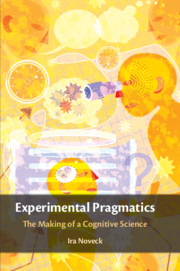Book contents
- Experimental Pragmatics
- Experimental Pragmatics
- Copyright page
- Dedication
- Contents
- Figures
- Tables
- Preface
- Acknowledgments
- Abbreviations
- 1 Defining Pragmatics
- 2 Grice's Monumental Proposal and Reactions to It
- 3 The Experimentalist's Mindset
- 4 A Consideration of Experimental Techniques
- 5 Early Experimental Pragmatics
- 6 How Logical Terms Can Be Enriched
- 7 Grammatical or Semantic Approaches to Scalar Implicatures
- 8 Conditionals
- 9 Referring
- 10 Speaking Falsely and Getting Away with It
- 11 Irony
- 12 Pragmatic Abilities among Those with Autism
- 13 More Topics for Experimental Pragmatics
- 14 Opinionated Conclusions and Considerations for the Future
- Bibliography
- Index
- References
Bibliography
Published online by Cambridge University Press: 29 September 2018
- Experimental Pragmatics
- Experimental Pragmatics
- Copyright page
- Dedication
- Contents
- Figures
- Tables
- Preface
- Acknowledgments
- Abbreviations
- 1 Defining Pragmatics
- 2 Grice's Monumental Proposal and Reactions to It
- 3 The Experimentalist's Mindset
- 4 A Consideration of Experimental Techniques
- 5 Early Experimental Pragmatics
- 6 How Logical Terms Can Be Enriched
- 7 Grammatical or Semantic Approaches to Scalar Implicatures
- 8 Conditionals
- 9 Referring
- 10 Speaking Falsely and Getting Away with It
- 11 Irony
- 12 Pragmatic Abilities among Those with Autism
- 13 More Topics for Experimental Pragmatics
- 14 Opinionated Conclusions and Considerations for the Future
- Bibliography
- Index
- References
- Type
- Chapter
- Information
- Experimental PragmaticsThe Making of a Cognitive Science, pp. 227 - 248Publisher: Cambridge University PressPrint publication year: 2018



